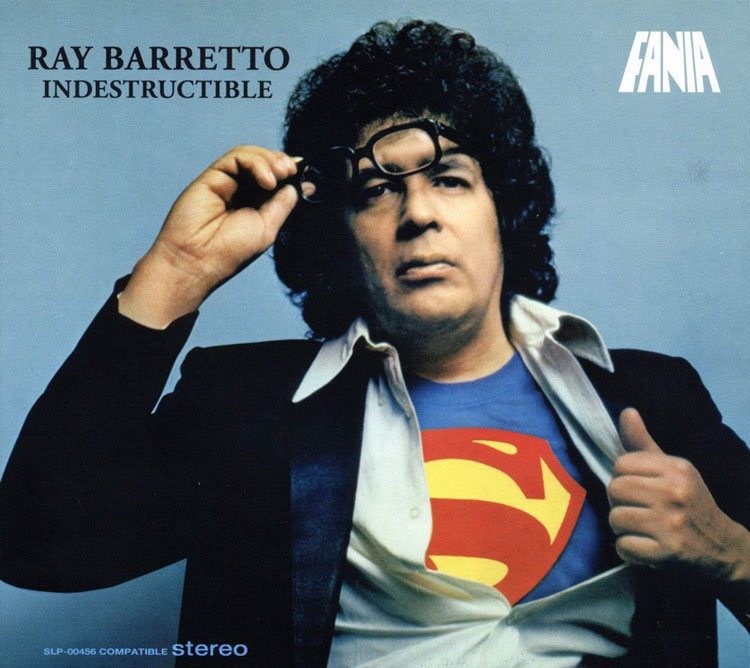Ray Barretto was born on April 29, 1929 in Brooklyn (New York City) of Puerto Rican parents. His first contacts with music came via the family radio. At the age of seventeen he joined the US Army and arrived in Europe where he first came across the recordings of Chano Pozo and Dizzy Gillespie, the earliest pioneers of the marriage between be-bop and the rhythms of the Caribbean.
He first sat in on jam sessions at the Orlando a GI jazz club in Munich. In 1949, after military service, he returned to Harlem and taught himself to play the drums, getting his first regular job with Eddie Bonnemere’s Latin Jazz Combo. Barretto then played for four years with Cuban band leader José Curbelo.
In the early 1950s, young Ray Barretto was playing his congas at the renowned Apollo Theater in Harlem; and when he walked out later that night he had impressed and performed with the legendary Charlie Parker. Since that evening of cubop, a mixture of bop and Latin rhythms he became a leading force in two worlds, Latin music and jazz.
In 1957 he replaced Mongo Santamaria in Tito Puente‘s band with whom he recorded his first album Dance Mania. After four years with Puente, he was one of the most sought-after percussionists in New York, attending jam sessions with artists including Max Roach and Art Blakey and recording with Sonny Stitt, Lou Donaldson, Red Garland, Gene Ammons, Eddie “Lockjaw” Davis, Cannonball Adderley, Freddie Hubbard, Cal Tjader and Dizzy Gillespie. Barretto was so much in demand that in 1960 he was a house musician for the Prestige Blue Note and Riverside record labels.
Unlike most Hispanic percussionists he arrived to Latin music from jazz instead of from Latin music to jazz. He attributed this musical path to his originality and believed it’s one of the reasons why he was sought after by so many legends of jazz.
Success came his way at the begining of the 1960s when Barretto formed his own band. The album Pachanga with Barretto (1961) was influenced by the boogaloo, a musical style that was to have a short-lived but considerable impact on the public.
In 1963 he was awarded a gold disc for the song “El Watusi“. The 1968 album Acid! was Barretto’s contribution to the psychedelic movement. This electrifying record now a classic opened up a memorable period in the history of the legendary Fania label.
The album Barretto (1975) brought Ray yet more success thanks to the explosive presence of the singer Rubén Blades. After a short stay at Atlantic Records, Barretto returned to Fania for the ambitious album Rican/Struction (1979) which is typical of the experimental spirit that presided over the Latin scene at the time.
The end of the 1980s saw him moving away from salsa and adopting a more jazzy direction playing with Eddie Gomez, Joe Lovano and Steve Turre. In 1981 he made a highly regarded album for CTI, La Cuna with Puente, Joe Farrell and Charlie Palmieri as guest players. He became music director of the Bravisimo television program and took part in the multi-idiom all-star anti-apartheid Sun City recording and video in 1985.
He won a Grammy in 1990 for the song “Ritmo en el Corazón” with Celia Cruz. In 1992 he unveiled a new Latin jazz sextet, New World Spirit which made albums for Concord Picante.
Trancedance came out in 2000, featuring Barretto on percussion, vibraphone; Greg August on bass; John Bailey on trumpet; Vince Cherico on drums; John Di Martino on piano; Adam Colker on tenor sax; James Moody on flute tenor sax; and Los Papines on percussion.
In 2003 he released the critically acclaimed CD, Homage to Art on the Sunnyside label. That same year Concord Picante released Hot Hands presenting two of Ray Barretto’s best, Ancestral Messages and Taboo in a specially-priced 2-CD collection.
While leading his own stellar Latin jazz bands, his congas graced more recording sessions than any other conguero. He was inducted into the International Latin Music Hall of Fame in 1999. He was voted Jazz Percussionist of 2004 by the Jazz Journalists Association and won the Down Beat critics poll for percussion in 2005.
In 2006 he received the National Endowment for the Arts (NEA) Fellowship. “To receive this honor is the gift of a lifetime. Jazz has been my spiritual babysitter since my youth in Harlem and the Bronx and I’ve spent my career trying to give something back. With gratitude and respect to everyone at the National Endowment for the Arts please allow me to consider myself still a jazz student,” said Barretto.
His last album was Time Was – Time Is.
Ray Barretto died February 17, 2006 at 5 a.m. at the Hackensack University Medical Center in Hackensack, New Jersey.


